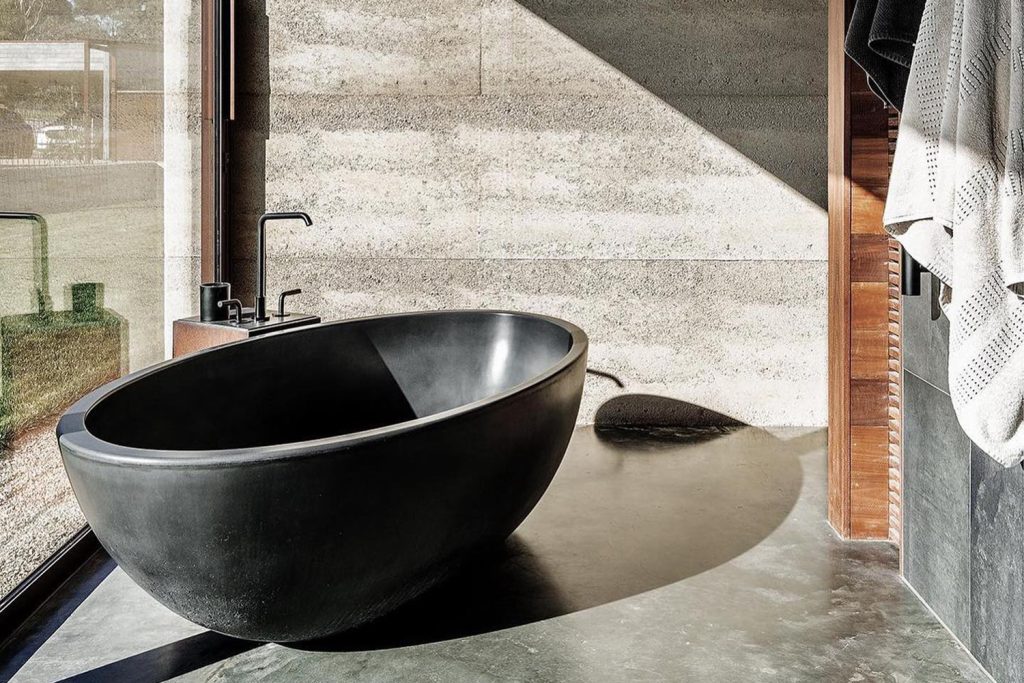GFRC (Glass Fibre Reinforced Concrete) is an innovative building material that is transforming architecture and construction across Australia. Combining the strength and versatility of concrete with the flexibility of glass fibres, GFRC unlocks new creative possibilities for structural and aesthetic designs.
At Domcrete, we are pioneering the use of GFRC in Australia. After discovering this groundbreaking material overseas, we knew we had to bring it back home. We are now supplying proprietary GFRC mixes and educating builders, architects and designers on how GFRC can enhance their projects.
Our team is passionate about the potential of GFRC. Let us show you what makes this composite material such an exciting game-changer.
Unleashing Creative Freedom
GFRC’s plasticity liberates designers from the constraints of traditional concrete. It can be cast into sweeping curves, organic shapes, delicate patterns and textures that are impossible with regular concrete. GFRC opens the door to free-flowing forms, ornamental decorative facades and structural elements with artistic flare.
Integrally coloured GFRC also breaks concrete’s grey shackles. From deep hues to pastels, and metallic finishes to faux wood and stone, GFRC offers a vast colour palette for maximum visual impact.
GFRC’s unique combination of strength, plasticity and integrally coloured finishes means architects can reimagine what’s possible with concrete. Natural shapes and patterns, graceful arches, even kinetic facades – if you can design it, GFRC can bring it to life.
Exceptional Performance
Despite its plasticity, GFRC maintains incredible strength, durability and resilience. Microglass fibres reinforce the material’s tensile capacity while remaining ultra-thin and lightweight. Elements as slender as 16mm can span multiple metres while weighing 75% less than regular concrete.
GFRC’s high strength-to-weight ratio also makes it easier to transport, handle and install. Reduced structural loads open up possibilities for bold cantilevered designs. Panels can be made larger and anchored with fewer connection points.
Even in harsh environments, GFRC retains its integrity. It resists cracking, chipping and damage from weather, salt, and chemicals. With minimal maintenance, GFRC installations can achieve a service life of over 50 years.
Local manufacturing also boosts GFRC’s sustainability credentials for Australian projects compared to imported materials.
The Ideal Facade Solution
GFRC is the ideal alternative to materials like natural stone, metal, ceramics and fibre cement for building facades. It replicates their look at a fraction of the weight and installation cost. GFRC panels can also be produced in any shape, scale, colour and finish to perfectly realise a design vision.
Seamless visual continuity can be achieved across large facades through GFRC’s mouldability. Panel joints are far less noticeable than alternative materials. Features like edges, reveals, grooves and institutional lettering can be incorporated during casting.
GFRC’s lightweight nature requires less structural support, reduces subframe complexity and makes installation faster. Panels can be produced upfront and then rapidly mounted onsite to minimise disruption.
Whether designing an artistic masterpiece, large-scale commercial facade or unique residential project, GFRC delivers the freedom and performance to make it stand out from the crowd.
GFRC versus Traditional Concrete
GFRC offers some key advantages over traditional steel-reinforced concrete:
- Weight – GFRC panels are much lighter than traditional concrete, making them easier to transport, install, and use in structures where weight needs to be minimised. GFRC can weigh 80% less than conventional concrete.
- Strength – The glass fibre reinforcement provides GFRC with added tensile and impact strength versus traditional concrete. It has a high strength-to-weight ratio.
- Workability – The concrete mixture used for GFRC has a soft, malleable consistency that allows it to be moulded into detailed shapes not possible unlike regular concrete.
- Durability – GFRC has improved resistance to cracking and breakage compared to traditional concrete. The glass fibre reinforcement provides durability even when the concrete may crack.
- Design Flexibility – GFRC allows for very slender, decorative, and complex shapes to be constructed out of concrete. Traditional concrete formwork is much more limited in design possibilities.
- Weather Resistance – The polymer admixtures mixed into the GFRC improve its water and freeze-thaw resistance compared to conventional concrete. It holds up better in outdoor environments.
The GFRC Revolution
GFRC represents a new frontier of possibility for architectural concrete. After introducing Australia to this trailblazing material, we are now leading education and product development. Our unrivalled expertise, rigorous R&D and use of globally proven mix designs ensure optimal GFRC quality and performance.
We also offer professional guidance and hands-on training to take advantage of GFRC’s immense potential. From initial concepts to successful installation, our end-to-end support delivers standout project outcomes.
GFRC is transforming concrete from a purely functional material into a limitless creative medium. If you’re ready to push boundaries and give your next project the “wow” factor, discover how GFRC can make it happen. The future of architectural design is here.



 Monday to Thursday: 8.30am – 5.00pm Friday: 8.30am – 4.30pm
Monday to Thursday: 8.30am – 5.00pm Friday: 8.30am – 4.30pm